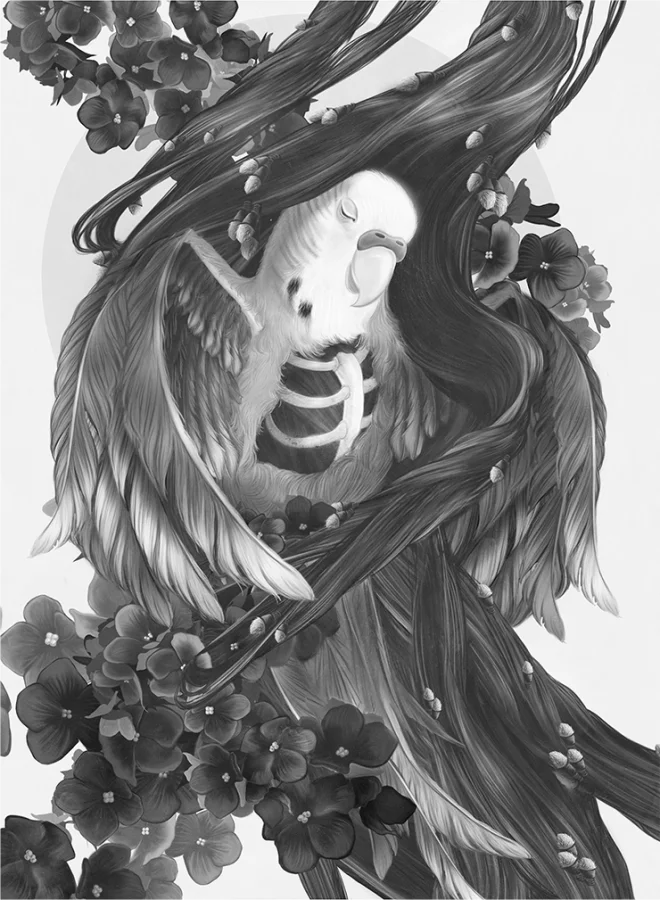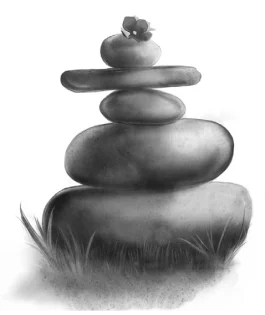My first distinct memory in a garden was about death—and I’d almost forgotten it.
Yesterday I was driving through an unfamiliar neighborhood, searching for a garage sale I’d read about, and my eyes spotted a small wooden cross, painted white, beneath a tree. I realized that someone’s beloved pet must be buried at that spot—and almost immediately remembered the day my grandmother buried her dead budgerigar, rolled up in a handkerchief, beneath the pussy willow in her garden.
I don’t believe I’d thought about that incident for at least 30 years, but it returned to me, complete and in detail. I was amazed the memory could have lived inside, undisturbed, for so long—and then be summoned instantly by a glimpse of a cross under a tree. It happened almost 50 years ago. I was four years old and excited to be permitted to walk all by myself to my grandmother’s house. Grandma lived in the next house over from ours, but we lived outside town, and her house wasn’t visible from ours. It was a major milestone in my young life, my first thrill of independence. There was one rule: I couldn’t go past the mailboxes near the road. I had to go the back way, past a hayfield, underneath the wild cherry tree that leaned over the path (at such an angle that I dashed quickly under it every time because I imagined it might fall on me), and through a small orchard of apple and pear trees, finally emerging near Grandma’s cold frame behind the garage.

Then it was time to play Find Grandma. She might be any-where. Sometimes she was in the house, but who knew where? The kitchen? Upstairs? In the basement? More often she was outside, perhaps filling the bird feeder she kept stocked year-round, maybe kneeling on a scrap of old oilcloth in the garden pulling weeds, or reading the newspaper on the porch swing.
Then one day I found her digging a hole with her shovel.
“It’s for Budgie,” she told me. She led me inside to collect the tiny, still body of the bird that had lived for several years in the cage in her front room. Grandma unwrapped the cloth that held Budgie and stroked the blue feathers with a finger. Budgie lay on her side, her dark eye wide open but unmoving. It was the first time I’d been brought face to face with the reality of death. I couldn’t make sense of it. Just the day before, I’d watched Budgie tilt her head to the side, then plunge her beak into her dish and spray water in a little halo around her head. It was clear she’d never do that again.
Grandma rewrapped Budgie in the handkerchief and placed her body in the hole. We began sifting dirt through our fingertips. The brown soil soon covered the clean white cotton that had Budgie’s small body inside.
It felt all wrong to me. This was the way it had to be, Grandma told me. Budgie would live now in our memories of her. I fashioned a pile of small stones under the pussy willow to mark Budgie’s resting place, feeling very unsettled. If Budgie lived only in my memory, then she could cease to be altogether—I forgot a lot of things! Sometimes I forgot to close the latch on my rabbit’s cage and had to chase her around the yard. Sometimes I forgot that I was supposed to brush my teeth before I went to bed. Sometimes I couldn’t even remember my parents’ phone number, despite the fact that my mother rehearsed it with me on a routine basis. My memory challenges did not bode well for Budgie’s chances of immortality.
A little later, while pulling weeds, Grandma tried to impart the idea in a manner a four-year old could grasp. Budgie’s body beneath the dirt would slowly break down into its smallest, most basic components. Those elements would continue to exist. They would become part of the soil and help grow the plants in Grandma’s garden. Some would help to grow the pussy willow tree above Budgie’s grave. Some might even help grow plants like the sunflowers that formed the garden’s back border, and they might produce seeds destined to be eaten by another bird, and so become part of that new bird’s body.
This circle of life image captivated me and helped soften the edges of my sadness. Not only did it mean that Budgie would live on in a way that wasn’t dependent on my spotty memory, it also made it clear to me that death and life were inextricably intertwined—a lesson one learns time and again in a garden.
During the following year, my grandmother and I often shared memories of Budgie. As I held the ball of twine while Grandma tied her tomato plants to their wooden stakes, we recalled how Budgie used to hop back and forth between the two perches in her cage. When the morning moisture clinging to her plants shone in the sunlight, it reminded us how Budgie used to shake her head and send glistening water drops in all directions. And in the Autumn, while pulling out old plants by the roots, we tried to imitate the whistling little songs Budgie used to sing.
One day the next Spring, I arrived at Grandma’s and found her pacing off the rows for her new year’s vegetable garden. I settled down on the grass to watch—and saw a small patch of violets blooming right in front of Budgie’s pile of stones.
“Look, Grandma,” I said, pointing. “Those weren’t there last year.”

“No, they weren’t,” Grandma agreed. We decided they were Budgie’s violets. Already her little body, although it would never fly again, was helping to nourish the soil and grow new flowers. We both smiled.
And so my earliest garden memories center on life as much as on death, the two going around and around, linked together in every living thing.
That idea is as comforting to me now as it was when I was four years old. ❖


 Previous
Previous

